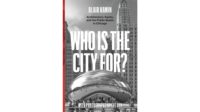Review of 'Modern Architecture: A Critical History (Fifth Edition)'
By Kenneth Frampton

Modern Architecture: A Critical History (fifth edition), by Kenneth Frampton. Thames & Hudson, 736 pages, $29.95.
Since the early 1960s, when his career as an architect and as technical editor for Architectural Design (AD) began in London, Kenneth Frampton has been one of the most effective advocates of an ethically informed approach to architectural design. Not only has he been a strong supporter of women in the field, his was also an influential early voice in calling attention to the need for architectural design to be part of what is now often called sustainability.
This textbook, originally published in 1980, remains a very thoughtful and usable overview of the development of modern architecture from the mid-19th century to around 2010. Drawn in part from Frampton’s earlier writings in AD and from Oppositions (the influential journal of the Institute of Architecture and Urban Studies that Frampton cofounded and co-edited), Modern Architecture has been an essential resource for generations of architecture students. Its compact design and enigmatic cover remain largely unchanged in this new edition, though at 736 pages, it is nearly twice the length of the previous edition, with more illustrations and new chapters that bring attention to less well-known works, many of them outside the West. As in the earlier versions, the author’s sharp insights and observations, informed by his deep knowledge of modern Western philosophers like Hannah Arendt as well as of 20th-century history and politics, situate the specific architectural works included. Frampton’s rare ability to concisely explicate the phenomenological, social, and technical aspects of the examples he has chosen, many of them illustrated by a variety of photographs and architectural drawings (some difficult to obtain elsewhere), ensure this book’s continuing value.
In the contemporary cultural environment, various political aspects of this canonical material may be difficult to appreciate. Responses to Philip Johnson, for example, whose politics Frampton never admired, have shifted radically since the first edition. Rather than valorize specific figures, Frampton’s intent is to identify the breadth of architectonic issues and responses found in modern buildings across the world, and to explain those in a succinct and coherent way, with the larger goal of making the field more socially and environmentally responsible.
Modern Architecture is also filled with excellent visual material, ranging from the historic photo of Walter Gropius and Le Corbusier at a Paris café table in the early 1920s, with Ise Gropius sitting nearby, to an iconic view of the then-recently completed Eames House in Los Angeles (1949) and Francis Keré’s primary school in Burkina Faso (2001). The text quickly conveys the story of how new ways of building and thinking about architecture have been transformative across the world.
Among the most valuable aspects of Modern Architecture are its many precise architectural drawings, which include detailed floor plans, sections, axonometrics, and analytic perspectives. Drawn by generations of architecture students, these differentiate the book from more standard architecture publications that consist mainly of photographs. As with any textbook, one can quibble about some of the specific project choices. Inevitably, for a book first published in 1980, the contemporary situation of the architectural profession within the real environmental legacies of racial segregation and gender and economic inequality could at points be more substantially addressed. Nonetheless, Frampton’s work still offers a greatly expanded and accessible historical introduction to many of the key issues and problems of contemporary architectural design.



